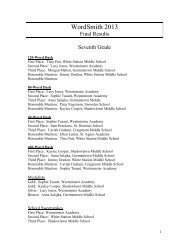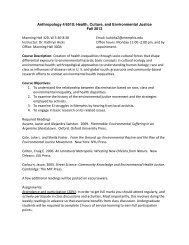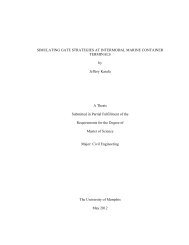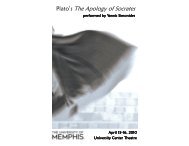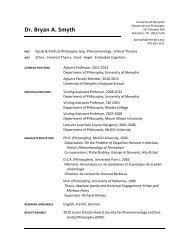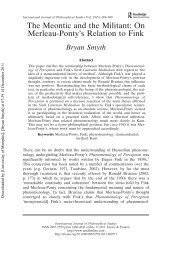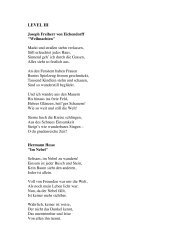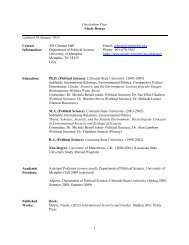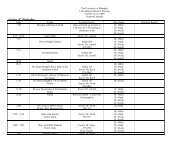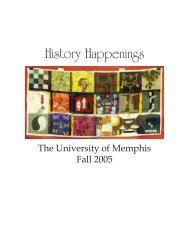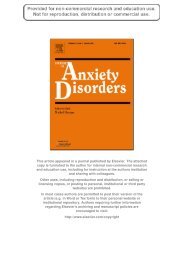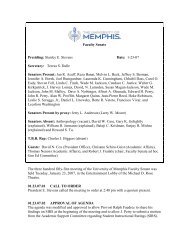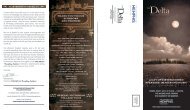Building Blocks Donor Appreciation Issue - University of Memphis
Building Blocks Donor Appreciation Issue - University of Memphis
Building Blocks Donor Appreciation Issue - University of Memphis
You also want an ePaper? Increase the reach of your titles
YUMPU automatically turns print PDFs into web optimized ePapers that Google loves.
the neighborhood through newsletters and<br />
coordinates the volunteers.<br />
Several U <strong>of</strong> M undergraduate and<br />
graduate civil engineering students<br />
teamed up with neighborhood volunteers<br />
to distribute flyers to all the residents<br />
informing them <strong>of</strong> the project and to see<br />
if residents wanted to be involved. The<br />
students also conducted surveys to find<br />
out what residents perceive as the biggest<br />
issues in terms <strong>of</strong> transportation and<br />
pedestrian safety.<br />
The project is developing a neighborhood<br />
Web site, which is published and<br />
updated by the U <strong>of</strong> M students.<br />
“We’re hoping to get somebody involved<br />
from the community that will take over so<br />
it will be a sustained effort to keep their<br />
community focused and on target,” says<br />
Ivey.<br />
The students have also done field work,<br />
including traffic counts through visual<br />
surveys and traffic counters. This information<br />
will be used to evaluate the need for<br />
traffic calming and signage.<br />
Local high school students have<br />
conducted sidewalk surveys by taking<br />
pictures <strong>of</strong> different sections. The neighborhood<br />
has also identified walkability<br />
corridors where they want people to walk,<br />
like routes to schools or to parks.<br />
“The main thing beyond the traffic part<br />
is to get more people in the neighborhood<br />
working together as a community and having<br />
a sense <strong>of</strong> community. We want them<br />
to recognize what could be if they got<br />
behind some <strong>of</strong> these things,” says Ivey.<br />
With the grant funding, the project was<br />
able to pay the students and to purchase<br />
equipment like traffic counters and road<br />
tubes.<br />
Mural Project<br />
(<strong>University</strong> District: $17,980)<br />
The <strong>University</strong> Neighborhood Development<br />
Corporation (UNDC) teamed with<br />
the College <strong>of</strong> Communication and Fine<br />
Arts’ Department <strong>of</strong> Art to create several<br />
Opposite, top: As part <strong>of</strong> a mural project<br />
aimed at the <strong>University</strong> District, a graphic<br />
design student carefully paints at the corner<br />
<strong>of</strong> Southern and Highland Avenues. Bottom:<br />
The <strong>University</strong> Neighborhood District<br />
Corporation has partnered with the U <strong>of</strong> M<br />
art department to create several murals that<br />
will be collaborative between art students and<br />
neighborhood residents.<br />
public art projects that will include community<br />
residents and young people in the<br />
design and implementation.<br />
“I kept hearing there was a need for<br />
some high pr<strong>of</strong>ile visual messages and<br />
symbols that represent the change that<br />
is going on around us and the revitalization,”<br />
says U <strong>of</strong> M alumnus Steve Barlow,<br />
executive director <strong>of</strong> the UNDC.<br />
Barlow and Cedar Nordbye, U <strong>of</strong> M<br />
assistant pr<strong>of</strong>essor <strong>of</strong> art, went to several<br />
community meetings to let the community<br />
know about the planned project and find<br />
participants for the steering and review<br />
committee.<br />
The first phase was to get people<br />
thinking about the project through various<br />
community meetings and temporary<br />
artwork. Barlow’s vision for the project is<br />
that the design concepts come from the<br />
community.<br />
“I wanted the artist to be the tool <strong>of</strong> the<br />
community expressing itself. The role <strong>of</strong><br />
artist as the brush <strong>of</strong> the community and<br />
channeling the neighborhood’s needs,”<br />
says Barlow.<br />
After getting input from business<br />
leaders, neighborhood residents and<br />
the <strong>University</strong>, Nordbye has already<br />
completed a temporary mural and two<br />
billboards that reflected the ideas from<br />
the community meetings to generate<br />
excitement about the permanent projects.<br />
Two neighborhood residents helped complete<br />
those projects in the Highland and<br />
Southern Avenue areas. The temporary<br />
art is intended to inspire questions and<br />
thoughts.<br />
“The community will have a say in the<br />
design. We will broadly collect input and<br />
Cedar will convey that message (in the<br />
artwork). They will critique what we’ve<br />
done so far and identify sites,” says<br />
Barlow.<br />
More permanent murals will come out<br />
<strong>of</strong> what the community wants. One <strong>of</strong><br />
Nordbye’s fall classes will come up with<br />
the concepts for public art projects by<br />
interviewing residents and going to community<br />
meetings. They will submit their<br />
art proposals that were created with community<br />
members and five <strong>of</strong> the proposals<br />
will be funded.<br />
Another part <strong>of</strong> the project will be children’s<br />
art workshops <strong>of</strong>fered in the spring.<br />
Eight to 10 Saturdays will be dedicated<br />
to teaching students in art education how<br />
to teach kids art. Immediately following,<br />
the art education students will lead free<br />
workshops for parents and kids.<br />
Abandoned Housing Study<br />
(Frayser Rugby neighborhood: $6,400)<br />
Gene Pearson, U <strong>of</strong> M pr<strong>of</strong>essor<br />
emeritus <strong>of</strong> city and regional planning,<br />
is embarking on a study with the Frayser<br />
Community Development Corporation<br />
(CDC) that is seeking to improve the<br />
housing values <strong>of</strong> the neighborhood.<br />
The Frayser CDC is a nonpr<strong>of</strong>it housing<br />
developer which provides foreclosure<br />
counseling and home-buyer education.<br />
“The real estate market is in tremendous<br />
crisis everywhere, but particularly in<br />
Frayser. There are a lot <strong>of</strong> empty houses<br />
and housing values have plummeted,”<br />
says Steve Lockwood, executive director<br />
<strong>of</strong> the Frayser CDC.<br />
The housing market caused the CDC to<br />
take a drastic step — a rental program.<br />
Although the CDC’s focus is homeownership,<br />
they wanted to address the empty<br />
houses.<br />
“We either leave them empty, let landlords<br />
pick them up who are <strong>of</strong>ten not our<br />
favorite people, or we have to get them,”<br />
says Lockwood.<br />
Since Frayser is large, the CDC chose<br />
Rugby, a historic neighborhood and gateway<br />
to Frayser.<br />
“The housing stock is pretty degraded,<br />
but it’s beautiful — meaning it’s rolling in<br />
green,” says Lockwood.<br />
The plan is to buy 60 rental properties,<br />
fix and rent them, then see if it will drive<br />
housing values up.<br />
“People have already lost an awful lot<br />
<strong>of</strong> value and <strong>of</strong>ten times it’s more than the<br />
house is worth,” says Lockwood.<br />
Besides lowering the density <strong>of</strong> abandoned<br />
houses, the CDC will also provide<br />
the renters with ongoing credit counseling<br />
and financial education to help improve<br />
their financial status and hopefully<br />
encourage them to become homeowners.<br />
The purpose <strong>of</strong> the study is to collect<br />
data and help the CDC look intensely at<br />
and identify the worst stuff. The funding<br />
has supported U <strong>of</strong> M graduate student<br />
Zach Schauffler to do data collection.<br />
Lockwood is hoping to cross reference<br />
the data and find out which ones aren’t<br />
owner occupied.<br />
“There may well be that some problematic<br />
investors will reveal themselves. If<br />
we find that some guy owns 12 houses, all<br />
<strong>of</strong> which are empty, we’ll make a particular<br />
effort to go after those properties. You<br />
don’t know about them until you study,”<br />
says Lockwood.<br />
Gene Pearson is a master planner and<br />
his role along with one <strong>of</strong> his classes is to<br />
take all <strong>of</strong> the information on the houses<br />
and ownership patterns and build a business<br />
plan telling the CDC how and where<br />
to buy houses.<br />
“There are more expensive houses that<br />
are easier to get into and up and running<br />
and rented, but there are more dilapidated<br />
houses that would have a more<br />
advantageous effect,” says Lockwood.<br />
14 THE UNIVERSITY OF MEMPHIS<br />
FALL 2008 15



